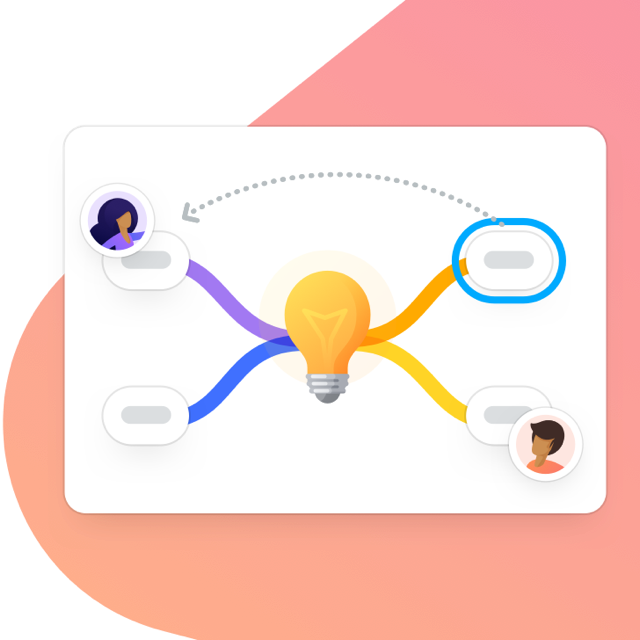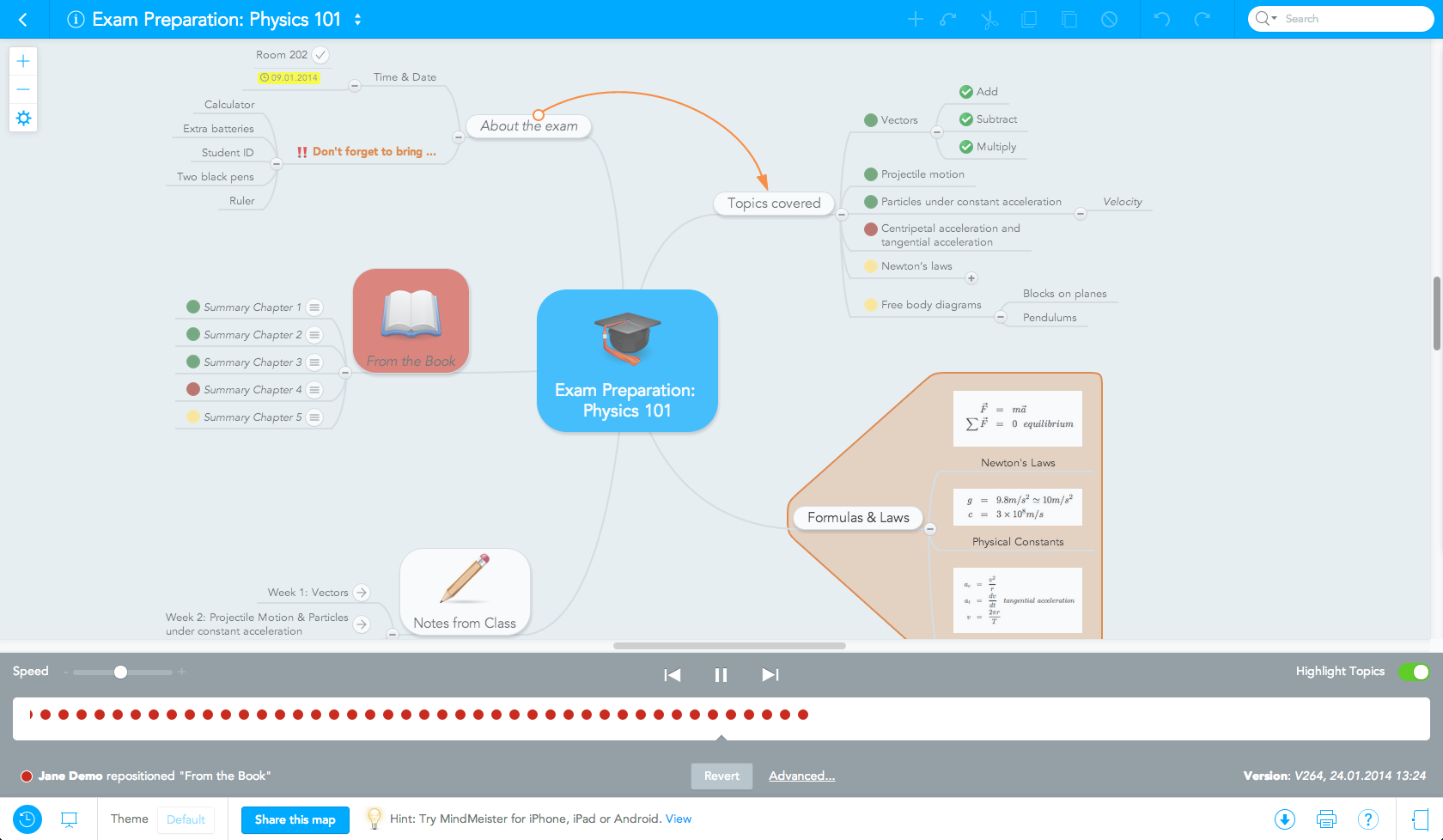Thousands of teachers all over the world already use and teach mind mapping in their classrooms. As one of the most effective learning techniques, mind mapping can help students take better notes, improve comprehension, and foster creativity.

Research from author and visual-thinking expert Nancy Margulies found that when children learn to write down concepts on lined paper rather than visualize those concepts mentally, their creativity begins to fade. Mind mapping helps students reignite their creativity, promoting ideas through association, and introducing an engaging, visual, and memorable approach to learning.
In this guide to mind mapping for teachers, we’ll provide an example mind map lesson plan you can use to teach your students the basics of mind mapping, offer four example mind mapping activities you can do in class, and even show you how you can use mind maps every day in the classroom to make your lessons more interactive and engaging.
Table of Contents:
- The Best Mind Mapping Tool
- An Example Mind Map Lesson Plan
- Mind Mapping Activities for Students
- Examples of Mind Mapping for Teachers
The Best Mind Mapping Tool for Teachers and Students
MindMeister is an excellent mind mapping tool for teachers and students. Here are some of the benefits of using MindMeister to build mind maps in an educational setting:
- It’s an online tool that lets students collaborate with their teachers and peers and doesn’t require any special software to be downloaded to a student or school computer.
- It arranges bubbles neatly as they’re added, so there’s no need to draw and redraw mind maps over and over again due to the confines of a sheet of paper.
- Students can add images and links to their mind maps, making it easier for them to collect all of their notes and sources in one place.
Took the students less than 5 minutes to become familiar with @mindmeister to “mind map” out their personalities traits this week #edtech I recommend it to educators needing a tool to quickly categorize, organize, brainstorm or conceptualize with their students
— John Allan (@mrpottz) January 21, 2018
We offer a free-forever plan that teachers and students can use to build mind maps. Or if you need more features or plan to use mind maps as a core part of your school’s curriculum, you can sign up for one of our education plans that start at $0.99/user per month.
Try Mind Mapping in Your Classroom
Get started for freeUse This Mind Map Lesson Plan to Teach Mind Mapping
If you want a simple way to teach mind mapping to your students, you could simply walk your class through our Mind Mapping 101 course, a 50-minute, 10-lesson collection of tutorials that will help everyone get familiar with the basics of mind mapping.
But if you want to take a more interactive approach, use this example mind map lesson plan.
Step 1: Start by building a mind map as a class
During class, begin by writing “I work best when…” in the center of the board. Get the ball rolling with a few examples: “I work best when I’ve recently played a sport,” or “I work best when I’ve sketched out my ideas using colorful pens.” Write each example on a new line that connects it to the center.
Next, invite your students to provide suggestions and add them to the board as they are given, connecting each suggestion to the center with a new line.
You’ll soon end up with a basic mind map.
If your students have used mind mapping before, they may recognize the format. If not, introduce the concept and discuss some of the benefits with them.
On the projector, you could also share some examples of how students can use mind mapping in class to take notes, when brainstorming for an essay or project, or at home while reading or studying. Check out our student’s guide to mind mapping for lots of relevant examples to share.
Step 2: Make a dreaded assignment easier with mind maps
Students often dread writing essays, so they’re sure to be grateful for learning a new trick that will make the task easier. As it so happens, one of the best uses of mind mapping is for essay writing.
Using mind maps, students can easily brainstorm ideas for the topic of their essay; they can collect arguments, quotes, and other information from various sources; and they can visually outline the structure of their essays.
Introducing @mindmeister to help my students stay organized and be creative during brainstorming activities! #psstech
— Connie Conner (@stallionccc87) March 30, 2017
Students are sure to warm up to the mind mapping technique once they see how much easier it is to write an essay when they’ve first visualized all of their arguments and created a proper structure for them.
We’ve put together a step-by-step guide on essay writing with mind maps that you can study before introducing the ideas to your class or share with your students.
Step 3: Have students create a mind map for homework
Assess pupil progression by setting your students the task of creating their own mind map for homework using a home or school-library computer.
Building a mind map for simple brainstorming is a good way to get them started as there are no right or wrong ideas and students are completely free to note down any and all thoughts related to the topic they are given.
If you’re planning on giving students a writing assignment about a certain topic, ask them to brainstorm ideas for the essay in a mind map first.
4 Example Mind Mapping Activities for Students
If you aren’t planning to have your students write an essay anytime soon, that’s okay. You can simply substitute step two of your mind map lesson plan with any of the mind mapping activities for students below, many of which were recommended by teachers in the MindMeister community.
1. Revision mind map
A few weeks or months after introducing students to a new topic is the perfect time to do a quick review of what you’ve learned so far in order to deepen students’ understanding of the material and help them memorize it long-term. Creating a revision mind map is perfect for this purpose.
I mentioned the fantastic @mindmeister to a few colleagues just the other day. Walking past a classroom today and an excited teacher calls me in to show the excellent revision map her class had produced. #edtech #Impressive pic.twitter.com/FdX0eSCmjO
— Stephen Wiles (@musictheoryguy) May 21, 2019
At the beginning of class, ask your students to open a new, blank mind map in MindMeister and write your subject and the year in the center of the map. If you’re covering a specific theme or subject area this year, they can write that in the center topic as well.
Now, give students five minutes to create a mind map of the material you’ve covered so far. The structure of the map is not important at this point. Instead, students should do a kind of brain-dump where they let their thoughts flow freely and simply note down anything they can remember.
They may end up with something like this:
When the five minutes are over, project your own version of the mind map onto the screen. You can either prepare it up front or create the map live in front of the students’ eyes. Ask students to compare their brain-dump to your map, adding keywords they may have left out and rearranging their topics to fit with your structure.
To finish this exercise, tell students what you will be discussing today, and show them how this new topic connects to what was covered before. Ask them to add this new topic to the mind map in the appropriate place.
2. Mind map presentation
Mind maps aren’t just great for brain-dumps, they’re also fantastic presentation tools. They show how individual pieces of information are connected and let students see the bigger picture. This helps them comprehend and retain information more easily.
Mindmeister helps students organize, analyze, and create! Students can also give flashy presentations as ppt alternative. #techinpedagogy
— Gregory Foschi (@gfoschslms17) June 19, 2017
Instead of having students create slide decks for the next topic they’re going to present to the class, have them create a mind map. This will help their peers spot connections and will prevent students from just reading from a slide deck while presenting.
3. Group assignment
Group assignments are supposed to encourage collaboration between students. In most cases, however, one or two students will sacrifice themselves to do all the work while the rest will just goof off and play with their phones.
My “Literature, Science & Technology” course made a collaborative map of our #bandersnatch viewing with @mindmeister, and I think it’s too cool. @EGLStonyBrook pic.twitter.com/JLTm3pziip
— Jon Heggestad (@jonheggestad) June 27, 2019
Group mind mapping can change that. Tools such as MindMeister enable multiple students to all work on a mind map at the same time. In contrast to a bullet-point list or text document, everyone can easily add their own contributions to the map wherever they fit.
MindMeister also offers a historical view of all of its maps, allowing you to replay the entire change history of a mind map and see exactly who contributed what and when.
4. Reading comprehension exercise
Taking notes in a mind map while reading a complicated text can help students break down the information into more manageable chunks. They are able to capture thoughts and questions that arise while they’re reading, and they can visualize connections between individual arguments and facts presented to them.
Using @mindmeister to organize main ideas & supporting details of nonfiction articles @OrchardLaneSDNB @SDNBSchools pic.twitter.com/NOrukJZgTG
— Jenny Schlie-Reed (@SchlieReed) April 6, 2016
A good way to ensure they capture the key points of the text is by providing them with a mind map template that they can fill in at home. A typical reading comprehension template for a novel might include branches for the main characters, themes, motives, plot points, and some background information about the book and the author.
For nonfiction texts, a typical template could look something like this:
Of course, the same principle can also be used to help students comprehend a complicated movie, documentary, or play.
Ss using #mindmeister to create idea webs to discuss the various conflicts in The Crucible. #tech #collaboration pic.twitter.com/Y137Mimo0C
— Jordyn Kahlbaugh (@jkahlbaugh) May 20, 2016
When they’re done, students can either share their mind maps with you (via link or email) or discuss them in a group setting in class.
Mind Mapping for Teachers: 6 Ways to Use Mind Maps in the Classroom
Mind mapping isn’t just an activity you teach to your students, it’s also one you can actively use every day in the classroom to improve collaboration and achievement.
Students are more likely to understand and retain information when it’s displayed through a combination of words and imagery. Mind maps offer a fantastic format that combines not only words and images but also colors, a graphical structure, and other mental triggers that improve long-term memory.
Here are six great ways you can use mind maps in your classroom and lessons every day.
1. Create a curriculum overview or lesson plan
At the beginning of the semester, prepare a curriculum overview or lesson plan mind map that provides an introduction of all of the topics you’re planning to cover.
You can also add exam dates and learning goals to the mind map and attach worksheets. Then, share this map with your students so they can use it as a guide during the semester and find out what they need to catch up on if they’ve missed a class.
Just revolutionized my semester plan using MindMeister. Can even sync links to the course objectives + activities! pic.twitter.com/BjhUSPG09S
— Melissa Davies (@MeliDavies) January 11, 2016
2. Organize and manage class projects
If you’re planning a project with your students, you want to make sure everyone knows exactly what they are supposed to do. What’s more, you probably want a central place where all project-related information is stored and can easily be accessed and updated.
A mind map is a great format you can use to create a visual overview of a whole project. You can add a description of the assignment, provide deadlines, add links to useful websites, embed examples, and more.
3. Create engaging presentations in less than three minutes
Mind maps are a great tool to present complex concepts to your students. Drawing a mind map live in front of your students will help them follow your train of thought more easily. They will also be able to see how individual ideas are connected, and when your map is finished, they will be able to see the big picture.
You can use MindMeister to put together a mind map and then simply turn it into a slideshow. The great part about this is that it takes no time at all—you can create an engaging presentation in less than three minutes. Take a look at the real-time video below to see how this works:
4. Create discussion templates and foster critical thinking
Create topic and discussion templates and circulate them to all of your students. These templates may either be filled in by students or used as a springboard to create their own maps.
Anthony Valentin, a World History teacher at New York City’s Stuyvesant High School, says, “I often use MindMeister to elicit responses to questions posed after students had watched a film or read a document. Other students can then edit and/or substitute their own commentary.”
“The goal is to get students to critically think about sources and share their thoughts. We review the work in class by projecting the mind map on a screen,” Valentin says.
A6: Ss co-used @mindmeister to create a mind map that identified the components of a mystery while reading a mystery mentor text. Pairs were then able to share their maps with others in the class and leave comments/feedback. #ETCoaches #innovate28 pic.twitter.com/oETF2zBoZj
— Tara LaCerra (@lacerrareads) January 24, 2018
5. Facilitate oral exams and lesson reviews
If you want to test how much a student knows or understands about a certain topic, let them draw a mind map about it and explain it simultaneously, either on the blackboard or on a piece of paper. This will give you insight into the student’s thought process and show whether they’ve really grasped the fundamental ideas of the topic and how they’re connected.
At the same time, the act of drawing the mind map will put your student’s brain into action. Instead of forgetting big chunks of information due to nervousness and stress, the mind map will help them relax and enable their brains to retrieve information more easily.
My amazing DP students using a #mindmap to present #derechoshumanos #IBteachers #LISlearning pic.twitter.com/GmlarF6Wpe
— Shei Ascencio (@Shei_Asc) November 29, 2016
6. Create games, quizzes, and questionnaires
The use of mind maps isn’t limited to brainstorming and project planning. You can also use this versatile tool for games, quizzes, and questionnaires.
For example, here’s a “Find the matching pairs” mind map, or check out the simple geography quiz below:
There Are Lots of Ways to Use Mind Maps in the Classroom
We hope you now feel ready to teach mind mapping to your students and thus provide them with a valuable skill they will benefit from for the rest of their lives.
Besides essay writing, mind mapping can be helpful for all kinds of educational tasks such as note-taking, creating engaging presentations, and more.
For more ideas on how to utilize mind maps in the classroom, take a look at these articles:
- Case Studies: Mind Mapping in the Classroom
- Get Inspired With These 13 Mind Map Examples
- 8 Lesson Ideas That Promote Lifelong Learning
- 8 Inspiring Examples of Educational Mind Maps
- Easy to Use Mind Map Templates for Teachers and Students
Originally published in July 2016, this post has been updated to consolidate three blog posts into one in order to create a more comprehensive guide to mind mapping for teachers.
Try Mind Mapping in Your Classroom
Get started for free












